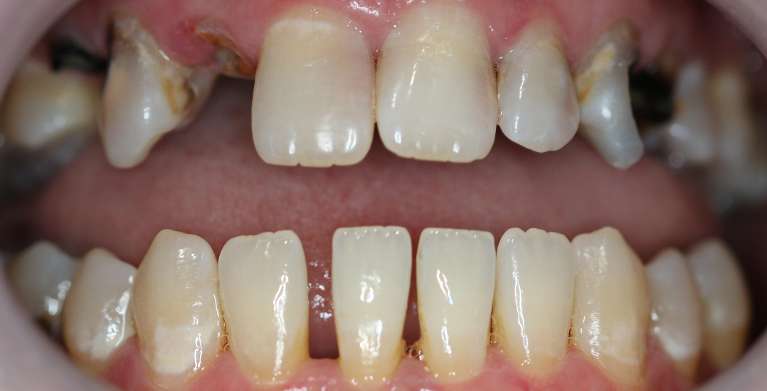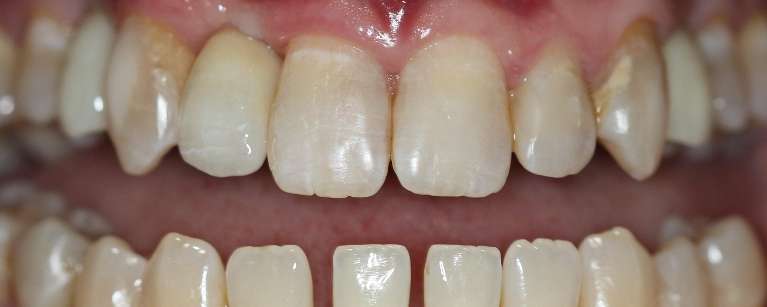Implant tooth replacement is the most advanced dental technology available for the reliable replacement of a missing tooth.
An implant supported crown involves the placement of a titanium support screw within the jaw bone to which is attached a crown (artificial tooth) made of metal and ceramic. If more than one tooth is missing, an implant bridge can be used. This involves two or more implant screws used to support a series of connected crowns (also known as bridge).



Implants can also be used to hold dentures in place for those who have no remaining teeth.

A full mouth bridge can also be placed on 4 implants (All-on-4® bridge) to provide a replacement for missing teeth.

A single implant screw can be inserted in the jaw bone via a simple surgical procedure under local anaesthesia. If several implants are necessary, general anaesthesia might be required.
What are the requirements for successful implant placement?
It is essential that the site where the implant is to be placed consists of healthy bone in sufficient quantity. It is therefore necessary to carefully assess the area for bone quantity and quality before implant placement. Imaging scans and radiographs are carried out to assess the potential implant site. If there is not enough bone thickness to accommodate the length of the implant screw, bone augmentation surgery is necessary.
Bone augmentation involves grafting bone taken from another site in the body to the area in the jaw where the implant is to be placed. A synthetic material can also be used for bone augmentation. In cases where an implant is to be placed in the upper jaw, the sinus cavity in the facial bone might not allow enough bone thickness for the implant screw. In these cases,
a procedure know as a sinus lift might be necessary as well as bone augmentation.
Patients wich active gum disease must first get treatment to improve their gum health before implants can be considered. A history of gum and poor oral hygiene is more highly associated with failure of implants.
Smoking is also a risk factor that decreases the success rate of implants.
How is the implant placed in the jaw bone?
At the Melbourne Smile Clinic, all implant surgical procedures are carried out by qualified specialists- periodontists or oral surgeons- who have received additional training for the safe and precise placement of implants and for more complex bone augmentation and sinus lift procedures.
For most cases, placement of the implant is carried out under local anaesthesia.
After placement of the implant in the jaw bone, the implant site is allowed to heal for 6- 8 weeks so the implant successfully 'integrates' into the bone. If the implant is loaded too early or the bone fails to heal properly, the implant might not integrate and remain loose. The crown can only be placed over the implant when the implant is firmly integrated in the bone and not movable.
After this healing period, the implant will be tested for any movement. If no movement is detected, it means the implant screw has integrated and ready to have the crown placed.
How is the crown placed on the implant?
Once the implant has successfully integrated, our dentist will take scans and models of the patient's mouth with the implant. These are used to determine the shape and shade of the crown so that it matches the natural teeth. The crown can then be manufactured and is then screwed onto the implant in the mouth.
Can implants fail?
Yes, implants can fail. Implants are made of titanium, a very biocompatible material and when the right protocols are followed for placement of the implant and the crown, the success rate is high. However, even the best implant is nowhere near as good as the original tooth designed and made by Mother Nature.
If the bone was insufficient to start with or there was uncontrolled gum disease, the implant can fail to integrate. A loose implant will eventually fall out.
If the patient has poor oral hygiene, this can cause inflammation of the gums around the implant. Chronic inflammation can lead to destruction of the bone around the implant, a condition known as peri implantitis. As the bone is destroyed, the implant can eventually loosen up and fall out.
The crown placed on top of the implant can get damaged. The crown is made of ceramic which can chip and fracture in the same way natural teeth do. However, since the crown is retained by a screw onto the implant, it can easily be unscrewed and removed for either repair or replacement.
If the forces acting on the implant are too heavy such as in patients with bruxism, the crown can get damaged or can loosen up. In severe cases, the screw that holds the crown to the implant can get damaged and need to be replaced. For patients with bruxism, it is recommended that a splint is worn to protect the longevity of their implants. For more information on splints, please read here
We will only consider implants if the tooth is too damaged to be saved or the cost of keeping the natural teeth outweighs the long-term benefit.
What implant systems do we use?
We prefer to use implant systems that have been researched and trialled and have been demonstrated by independent clinical studies to have a good success rate. We currently use genuine implant componentry from the following companies:


















